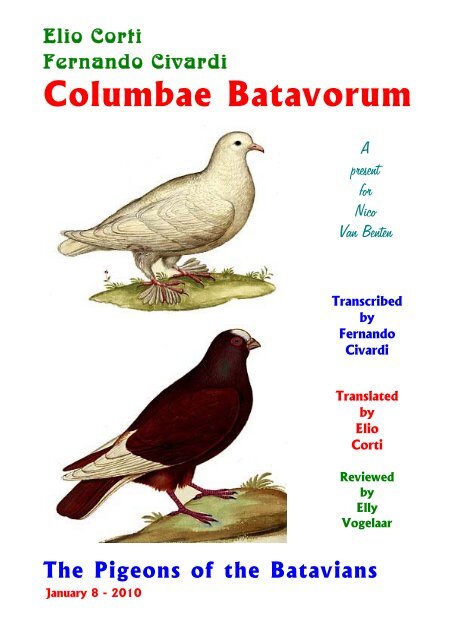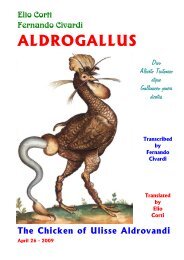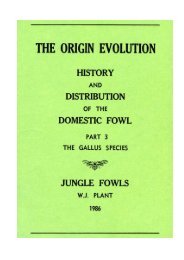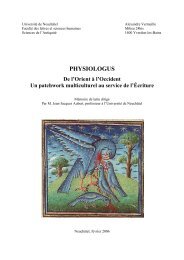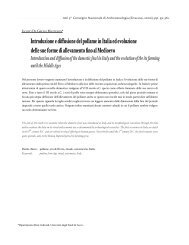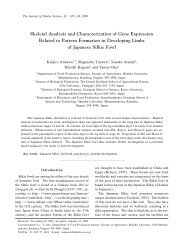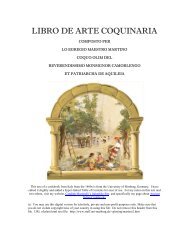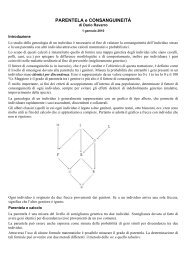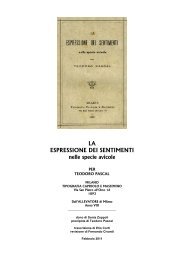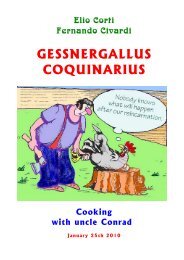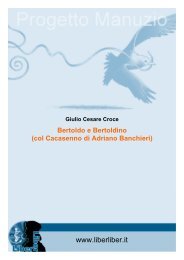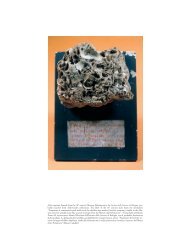Columbae Batavorum - Summa gallicana
Columbae Batavorum - Summa gallicana
Columbae Batavorum - Summa gallicana
Create successful ePaper yourself
Turn your PDF publications into a flip-book with our unique Google optimized e-Paper software.
Elio Corti<br />
Fernando Civardi<br />
<strong>Columbae</strong> <strong>Batavorum</strong><br />
A<br />
present<br />
for<br />
Nico<br />
Van Benten<br />
Transcribed<br />
by<br />
Fernando<br />
Civardi<br />
Translated<br />
by<br />
Elio<br />
Corti<br />
Reviewed<br />
by<br />
Elly<br />
Vogelaar<br />
The Pigeons of the Batavians<br />
January 8 - 2010
Ulisse Aldrovandi<br />
SECOND VOLUME OF ORNITHOLOGY -1600
The Batavians<br />
The Batavi - or Batavians - were an ancient Germanic tribe, originally part of the Chatti, reported by Tacitus<br />
to have lived around the Rhine delta, in the area that is currently the Netherlands, "an uninhabited district on<br />
the extremity of the coast of Gaul, and also of a neighbouring island, surrounded by the ocean in front, and<br />
by the river Rhine in the rear and on either side" (Tacitus, HISTORIAE IV). This led to the Latin name of<br />
insula <strong>Batavorum</strong> for the area. The Dutch applied the familiar name Batavia to their colonial factory on the<br />
island of Java, now Jakarta. The same name is applied to several military units, originally raised among the<br />
Batavi. The tribal name, probably a derivation from batawjō ("good island", from Germanic bat- "good,<br />
excellent" and awjō "island, land near water"), refers to the region's fertility, today known as the fruitbasket of<br />
the Netherlands (the Betuwe).<br />
The Batavi were mentioned by Julius Caesar in his commentary DE BELLO GALLICO, as living on an island<br />
formed by the Rhine River after it splits, one arm being the Waal the other the Lower Rhine/Old Rhine. The<br />
strategic position, to wit the high bank of the Waal -- which offered an unimpeded view far into Germania<br />
Transrhenana (Germania Beyond the Rhine) -- was recognized first by Drusus, who built a massive fortress<br />
(castra) and a headquarters (praetorium) in imperial style. The latter was in use until the Batavian revolt.<br />
Archeological evidence suggests they lived in small villages, composed of 6 to 12 houses in the very fertile<br />
lands between the rivers, and lived by agriculture and cattle-raising. Finds of horse skeletons in graves suggest<br />
a strong equestrian preoccupation. On the south bank of the Waal (in what is now Nijmegen) a Roman<br />
administrative centre was built, called Oppidum <strong>Batavorum</strong>. An Oppidum was a fortified warehouse, where a<br />
tribe's treasures were stored and guarded. This centre was razed during the Batavian Revolt.<br />
The Batavi moved into the Betuwe in the late 1st century BC. The previous inhabitants of the area were<br />
Celtic-speaking Gauls, as evidenced by the two Latinised Celtic names for their chief town: Batavodurum and<br />
Noviomagus (Nijmegen, Neth). [Birley (2002) 42-3] It is unclear whether the existing inhabitants were simply<br />
subjugated with the Batavi forming a ruling elite, or the existing inhabitants simply displaced. For this reason<br />
it is also uncertain whether the Batavi remained Germanic-speaking or adopted the Belgic Gallic tongue of<br />
the indigenes.<br />
The first Batavi commander we know of is named Chariovalda, who led a charge across the Visurgin (Weser)<br />
against the Cherusci led by Arminius during the campaigns of Germanicus in Germania Transrhenana<br />
(Tacitus ANNALES II, 11). Tacitus (DE ORIGINE ET SITU GERMANORUM XXIX) described the Batavi as the<br />
bravest of the tribes of the area, hardened in the Germanic wars, with cohorts under their own commanders<br />
transferred to Britannia. They retained the honour of the ancient association with the Romans, not required<br />
1
to pay tribute or taxes and used by the Romans only for war: "They furnished to the Empire nothing but men<br />
and arms", Tacitus remarked. Well-regarded for their skills in horsemanship and swimming — for men and<br />
horses could cross the Rhine without losing formation, according to Tacitus. Dio Cassius describes this<br />
surprise tactic employed by Aulus Plautius against the "barbarians" — the British Celts — at the battle of the<br />
River Medway, 43: "The barbarians thought that Romans would not be able to cross it without a bridge, and<br />
consequently bivouacked in rather careless fashion on the opposite bank; but he sent across a detachment of<br />
Germanic tribesmen, who were accustomed to swim easily in full armour across the most turbulent streams.<br />
[...] Thence the Britons retired to the river Thames at a point near where it empties into the ocean and at<br />
flood-tide forms a lake. This they easily crossed because they knew where the firm ground and the easy<br />
passages in this region were to be found; but the Romans in attempting to follow them were not so<br />
successful. However, the Germans swam across again and some others got over by a bridge a little way upstream,<br />
after which they assailed the barbarians from several sides at once and cut down many of them."<br />
(Cassius Dio, ROMAN HISTORY, Book 60:20)<br />
It is uncertain how they were able to accomplish this feat. The late 4th century writer on Roman military<br />
affairs, Vegetius, mentions soldiers using reed rafts, drawn by leather leads, to transport equipment across<br />
rivers. [Vegetius DE RE MILITARI III.7] But the sources suggest the Batavi were able to swim across rivers<br />
actually wearing full armour and weapons. This would only have been possible by the use of some kind of<br />
buoyancy device: Ammianus Marcellinus mentions that the Cornuti regiment swam across a river floating on<br />
their shields "as on a canoe" (357 AD). [Ammianus Marcellinus XVI.11] Since the shields were wooden, they<br />
may have provided sufficient buoyancy. The Batavi also provided a contingent for the Emperor's Horse<br />
Guard. Numerous altars and tombstones of the cohorts of Batavi, dating to the 2nd and 3rd century, have<br />
been found along Hadrian's Wall, notably at Castlecary and Carrawburgh, Germany, Yugoslavia, Hungary,<br />
Romania and Austria.<br />
Revolt of the Batavi - Despite the alliance, one of the high-ranking Batavi, Julius Paullus, to give him his<br />
Roman name, was executed by Fonteius Capito on a false charge of rebellion. His kinsman Gaius Julius<br />
Civilis was paraded in chains in Rome before Nero; though he was acquitted by Galba, he was retained at<br />
Rome, and when he returned to his kin in the year of upheaval in the Roman Empire, 69, he headed a<br />
Batavian rebellion. He managed to capture Castra Vetera, the Romans lost two legions while two others (I<br />
Germanica and XVI Gallica) were controlled by the rebels. The rebellion became a real threat to the Empire<br />
when the conflict escalated to northern Gaul and Germania. The Roman army retaliated and invaded the<br />
insula <strong>Batavorum</strong>. A bridge was built over the river Nabalia, where the warring parties approached each other<br />
on both sides to negotiate peace. The narrative was told in great detail in Tacitus' History, book iv, although,<br />
unfortunately, the narrative breaks off abruptly at the climax. Following the uprising, Legio X Gemina was<br />
housed in a stone castra to keep an eye on the Batavians.<br />
The fate of the Batavi - The Batavi were still mentioned in 355 during the reign of Constantius II (317-361),<br />
when their island was already dominated by the Salii, a Frankish tribe that had sought Roman protection there<br />
in 297 AD after having been expelled from their own country by the Saxons. Constantius Gallus added<br />
inhabitants of Batavia to his legions, "of whose discipline we still make use." [Zosimus, NEW HISTORY.<br />
London: Green and Chaplin (1814). Book 3.] It has been assumed they merged with the Salii shortly before<br />
or after and, after having been expelled by another tribe (it has been proposed this were the Chamavi), shared<br />
their subsequent migration to Toxandria, an ancient name for current Brabant after 358.<br />
The Batavian myth - In the 16th-century invention of a suitably antique origin myth for the Dutch people<br />
that would be expressive of their self-identification as separate from their neighbors in the national struggle<br />
with Spain of the Eighty Years War for Dutch independence, the Batavians came to be regarded as their<br />
eponymous ancestors. The mix of fancy and fact in the CRONYKE VAN HOLLANDT, ZEELANDT ENDE<br />
VRIESLAND (called the Divisiekronike), first published in 1517, brought the spare remarks in Tacitus' newlyrediscovered<br />
Germania to a popular public; it was being reprinted as late as 1802. Contemporary Dutch<br />
virtues of independence, fortitude and industry were rendered fully recognizable among the Batavians in<br />
more scholarly history represented in Hugo Grotius' LIBER DE ANTIQUITATE REPUBLICAE BATAVICORUM<br />
(1610). The myth was perpetuated by ROMEYN DE HOOGHE'S SPIEGEL VAN STAAT DER VEREENIGDEN<br />
NEDERLANDEN ("Mirror of the State of the United Netherlands", 1706), which also ran to many editions,<br />
and it was revived in the atmosphere of Romantic nationalism in the late eighteenth-century reforms that saw<br />
a short-lived Batavian Republic and, in the colony of the Dutch East Indies, a capital (now Jakarta) that in<br />
1619 was named Batavia until 1942. Modern variants of the Batavian founding myth are made more credible<br />
by pointing out that the Batavians were only part of the ancestry of the Dutch people, together with the<br />
2
Frisians, Franks and Saxons, and by tracing patterns of DNA. Echoes of this supposed cultural continuity<br />
may still be found in popularisations of the history that follows.<br />
Ulyssis Aldrovandi<br />
ORNITHOLOGIAE TOMUS ALTER - 1600<br />
Liber decimusquintus<br />
qui est de avibus, quae simul se pulverant, et lavant.<br />
Paginae 353-574<br />
Ulisse Aldrovandi<br />
SECOND VOLUME OF ORNITHOLOGY -1600<br />
15 th book<br />
about the birds both dust and water bathing<br />
Pages 353-574<br />
I - De Columbis in genere<br />
I - Generally about the pigeons<br />
354<br />
Nonne et apud nos nobiles familiae fere omnes<br />
Columbaria habent, in quibus habitant,<br />
educantur, ac nidulantur Sed etsi nos<br />
emolumenti causa eas alamus, Gallos tamen,<br />
maxime autem Belgas, ac inter hos Batavos<br />
ferunt adeo Columbarum studiosos esse, ut vel<br />
quarta saltem eorum pars eas ad animum<br />
duntaxat explendum enutriat. Aiunt insuper<br />
eosdem, quotquot reperiri queunt Columbarum<br />
genera, diligenter investigare, magno semper<br />
mercari pretio, laudes singularum in publico,<br />
privatoque conventu, in quo patritios etiam<br />
viros pauperioribus sese immiscere minime<br />
pudeat, modo de Columbis sermo sit, enarrare,<br />
Is it not perhaps true that also among us - Italians -<br />
almost all noble families have dovecotes, in which the<br />
pigeons live, are raised and nest But even if we raise<br />
them to draw a profit from them, nevertheless they<br />
report that French people, but above all the Belgians,<br />
and among them the Batavians, are passionately fond<br />
of the pigeons to such an extent that at least a fourth<br />
of them raises them only to satisfy his own mind.<br />
Furthermore they say that they investigate with<br />
diligence all the breeds of pigeon that can be found,<br />
that always they deal them at a high price, that they<br />
raise the praises of each pigeon both in public and<br />
private meetings in which also the noblemen are not<br />
ashamed to mix themselves to more poor people,<br />
3
adeo ut quod Plinius olim de Romanis, id nos<br />
etiamnum de Batavis dicere queamus,<br />
Columbarum scilicet amore insanire 1 .<br />
provided that they speak about pigeons, so that what<br />
formerly Pliny said speaking of Romans, still now we<br />
can say about Batavians, that is, to go crazy of love for<br />
the pigeons.<br />
Genera<br />
Breeds<br />
360-361<br />
[360] Verum nunquid M. Varro, Aristoteles,<br />
aliique veteres domesticarum Columbarum<br />
species, quas nostra tempora modo suppeditant,<br />
agnoverint, non dubito duntaxat, sed non<br />
adducor etiam, ut id credam, etsi antiquos<br />
Romanos Columbarum amore insaniisse probe<br />
norim, et ex Plinio ante retulerim. Tanta enim<br />
iamnum in Europa Columbarum reperitur<br />
diversitas, maxime, ut audio, apud Belgas,<br />
hosque inter apud Batavos, ut narranti mihi viro<br />
alioqui fide dignissimo vix fidem adhibere<br />
potuerim. Hos populos si quae ulla alia gens,<br />
Columbis impense delectari, ideoque quam<br />
plurima earum genera alere supra quoque<br />
memini. Dicebat autem vir ille praeter<br />
communes domesticas, et saxatiles, quarum<br />
insuper immensam habeant copiam, genus<br />
quoddam esse domesticis vulgaribus duplo fere<br />
maius, pedibus hirsutis, hoc est pennatis, quod<br />
inter volandum, et dum murmurat, id est vocem<br />
suam edit, fauces in tumorem ingentem adducit,<br />
quem quo maiorem, maxime in volatu<br />
ostendunt, eo nobiliores censeri, dici vero id<br />
genus Kroppers Duve, hoc est Columbas<br />
gutturosas, quo nomine pariter nobis veniunt<br />
nam quandoque etiam ad nos afferuntur.<br />
Ornithologus se Venetiis Columbas observasse<br />
tradit, quae Gallinaceos fere magnitudine<br />
aequarent 2 . Verum quod eas e Palumbarum<br />
maximarum cicuratarum genere esse credit,<br />
prorsus meo iudicio fallitur; Palumbes enim<br />
nunquam cicurantur. Caeterum num illae, quas<br />
in Batavia haberi vir ille narrabat, eaedem sint<br />
cum Campanis Plinii, qui in Campania maximas<br />
nasci scribit, non ausim affirmare, [361] quanvis<br />
interim id minime negarim. Bellonius certe eius<br />
plane sententiae est, et hallucinari eos asserit,<br />
In reality I not only doubt that Varro, Aristotle and<br />
other authors knew the ancient breeds of domestic<br />
pigeons still supplying in abundance the time we live,<br />
but I am not even induced to believe it nevertheless I<br />
perfectly know that ancient Romans went crazy of love<br />
for the pigeons, and previously I reported this, drawing<br />
it from Pliny. In fact also now in Europe a so great<br />
diversity of pigeons is found, above all, as I hear,<br />
between Belgians, and, among them, among Batavians,<br />
that hardly I would have been able to believe that man<br />
who was telling me this, on the other hand he was<br />
absolutely worthy of faith. Also previously I mentioned<br />
the fact that these people, more than any other, are<br />
pleased a lot with the pigeons and that therefore they<br />
raise a lot of breeds. In fact that man said that besides<br />
the domestic and the rock pigeons, of which moreover<br />
they have an enormous abundance, a breed exists<br />
which is larger almost the double in comparison with<br />
the common domestic ones, with hairy legs, that is<br />
feathered, which during the fly's breaks and while it is<br />
cooing, that is when it utters its voice, enormously<br />
blows up the throat, and as more as these pigeons<br />
show it blown up, above all during the flight, so much<br />
they are judged excellent, and this breed is named<br />
Kroppers Duve, that is, cropper pigeons, and they<br />
arrive among us with the same name, in fact<br />
sometimes they are exported also among us.<br />
The Ornithologist - Conrad Gessner - reports to have<br />
observed in Venice pigeons that for size almost were<br />
matching the chickens. In truth, for the fact to believe<br />
that they come from the breed of the enormous tamed<br />
wild pigeons, in my opinion he is completely wrong; in<br />
fact the wild pigeons never become tamed. Besides I<br />
would not dare to affirm that those pigeons that that<br />
man told to be present in Batavia are corresponding to<br />
those of Campania of Pliny, who writes that in<br />
Campania they are born of very big size, even if<br />
nevertheless I would not entirely deny. Without doubt<br />
1 Plinius Naturalis historia X,110: Quin et internuntiae in magnis rebus fuere, epistulas adnexas earum pedibus obsidione Mutinensi<br />
in castra consulum Decumo Bruto mittente. Quid vallum et vigil obsidio atque etiam retia in amne praetenta profuere Antonio, per<br />
caelum eunte nuntio Et harum amore insaniunt multi. Super tecta exaedificant turres iis nobilitatemque singularum et origines<br />
narrant, vetere iam exemplo. L. Axius eques Romanus ante bellum civile Pompeianum denariis CCCC singula paria venditavit, ut<br />
M. Varro tradit. Quin et patriam nobilitavere in Campania grandissimae provenire existimatae.<br />
2 Conrad Gessner Historia animalium III (1555) DE PALUMBE pagina 299: In columbaceo genere maximo corpore sunt palumbes,<br />
[GR]: inde [GR], ut in A. ostendi. Oenas maior est columba, minor palumbe, [GR]. phassa vero (id est palumbus maior)<br />
magnitudine est gallinacei, colore cinereo, Athenaeus Aristotelem citans: et Eustathius. haud multo minor parvis gallinaceis, Nic.<br />
Leonicenus. nonnullis locis gallinaceum aequat, Vuottonus. Ego tantas fere columbas memini videre Venetiis advectas, quae forsan<br />
huius generis palumbes cicuratae erant.<br />
4
qui Plinium, aliosque veteres eas non agnovisse<br />
putant. Christophoro Columbo Indi quoque<br />
Columbas obtulerunt inter alia munera<br />
nostratibus multo maiores, et gustu pariter<br />
suaviores, sed gustus itaque iudicaret, si cum<br />
superioribus eaedem sint, an diversae.<br />
Affirmabat vir ille, reperiri aliud genus hirsutis<br />
pariter pedibus, ac magnum, si communibus<br />
domesticis compares, parvas vero, si illis, id<br />
nostrates vulgo Tronfo vocant. Alere quoque<br />
Cyprias, seu, ut Ornithologus nominat,<br />
Russicas, et Anglicas, et Monachicas,<br />
Ferrarienses Sorellas, has appellare Kappers,<br />
hoc est, cucullatas, a crista nimirum, quae<br />
cucullum, quem Kappam vocant, propemodum<br />
aemulari videtur, et harum duo habere genera,<br />
unum pedibus pennis ornatis, alterum nudis:<br />
rursus omnes hasce diversorum colorum esse.<br />
Dari et aliud genus Cypriis simillimum, sed<br />
crista carens, et pedibus semper nudis, rostro<br />
nempe admodum exiguo: hoc dicere Cortbecke,<br />
id est, brevis rostri: esse ibi et aliud genus, quod<br />
{indigete} voce a gestu<br />
Overslagers nuncupent, quoniam in honorem<br />
faemellae vel suae, vel aliarum post longa<br />
murmura a terra sese elevet, et ultra illas<br />
volando alas quatiat.<br />
Quas vero ut nobilissimas colunt, eas appellare<br />
Draijers, quae non eodem, ut illae, modo, inter<br />
volandum duntaxat alas quatiant, verum etiam<br />
in orbem circum volitent, idque maxime supra<br />
faemellas tam fortiter alas quatiendo, ut duorum<br />
asserum simul collisorum sonitum superent,<br />
unde remiges earum pennae semper ferme<br />
fractae conspiciantur, ac quandoque etiam<br />
volare inde nequeant. Hoc genus aiebat in<br />
Venerem admodum pronum esse, faemellas,<br />
cum partui vicinae sunt, aliis etiam sui copiam<br />
dare, incolis autem in maximo pretio haberi,<br />
utpote quarum unum saepe par quatuor<br />
vendatur aureis; pedibus esse nudis, coloris<br />
varii, hoc est, dari cuiuscunque coloris, capite<br />
quandoque exigua crista plumea ornato,<br />
quandoque plano, has bollen, id est, planas<br />
vocare, illas gecopte, id est, capitatas.<br />
Haberi item ibi aliud genus aspectu<br />
elegantissimum, quod Helme dicunt, quasi<br />
galeatas. Harum enim alias capite, cauda, et<br />
alarum remigibus coloris esse albi, caeteras<br />
alterius coloris, puta nigri, rubri, lutei, caerulei:<br />
alias vero ex horum colorum aliquo caput,<br />
caudam, et remiges habere, caetera vel ex albo,<br />
Pierre Belon is completely of his opinion and affirms<br />
that those people who believe that Pliny and the other<br />
ancients didn't know them, are making a mistake.<br />
Among the other gifts, the Amerinds also brought to<br />
Cristoforo Colombo some pigeons greater than ours,<br />
as well as of more pleasant taste, and therefore the<br />
taste was able to express a judgment if they were<br />
identical to the just quoted ones or different.<br />
That man was affirming that another breed is found<br />
ever with hairy legs, and of great build if you compare<br />
it to the common domestic ones, but small if<br />
compared to those the Italians commonly call Tronfo.<br />
It seems that they compete in raising also those of<br />
Cyprus, or, as Gessner calls them, of Russia, as well as<br />
the English ones, the Nuns, the Sisters of Ferrara<br />
called Kappers, that is, hooded, just by a tuft, which is<br />
the hood they call Kappe, and that of these pigeons<br />
two varieties are existing: one with legs adorned with<br />
feathers, the other with naked legs; moreover, that<br />
both show various colours. Another breed also exists,<br />
very similar to those of Cyprus, but without tuft, and<br />
still with naked legs, and precisely with an extremely<br />
small beak: this breed is said Cortbecke, that is, with a<br />
short beak: there is also another breed that being<br />
without voice, according to its behavior, they name<br />
Overslagers, since it gives honor to the female, both of<br />
it own and of other breeds, it gets up from earth after<br />
long whispers, and overtaking them in flight it flaps the<br />
wings.<br />
But those they revere as excellent they call Draijers,<br />
which not only flap the wings like the previous ones<br />
while flying, but they also fly in a circle, and flapping<br />
the wings so strongly, above all over the females, to<br />
exceed the noise of two poles beaten each to other,<br />
whence their remiges are seen with some almost always<br />
broken feathers and that therefore sometimes they<br />
don't even succeed in flying. He said that this breed is<br />
extremely inclined to sexual intercourse, that the<br />
females, when near the laying, abundantly offer<br />
themselves also to other breeds, and that in actual fact<br />
by his fellow countrymen they are held of big value, so<br />
that if often their value is of a golden coin each, it is<br />
sold for four gold coins; they have naked legs, the<br />
colour is various, that is, they have whatever<br />
coloration, sometimes with the head adorned by a<br />
small tuft of feathers, sometimes flat, these are the<br />
'bollen', that is, they call them flattened, the former<br />
ones 'gecopte', that is, with big head.<br />
Likewise another breed is found with a very elegant<br />
aspect they call Helm, as if they were endowed with a<br />
helmet. In fact some of these pigeons show a white<br />
coloration at the head, tail and flight feathers, the other<br />
feathers have a different coloration, that is, black,<br />
golden, blue: but others show these colorations in<br />
other points, at head, tail, remiges; for the remainder<br />
5
vel ex alio quovis diverso, adeo, ut caput, cauda,<br />
remiges semper alius coloris sint, quam<br />
reliquum corpus. Quod modo ad tertium genus<br />
spectat, quod M. Varro miscellum vocat, id non<br />
solum ex Columbo domestico, et agresti<br />
faemina, vel contra, utile innuere videtur,<br />
generatur, sed ex domesticis ipsis diversae<br />
speciei procreari potest, atque id etiam quotidie<br />
conspicimus. Sed haec domesticis dicta<br />
sufficiant.<br />
they are white or of any other colour, so that the head,<br />
the tail and the remiges are always of another colour in<br />
comparison to the rest of the body. As far as the third<br />
breed is concerned, which Varro calls variegated, it is<br />
begotten not only by the domestic pigeon with a wild<br />
female, or it seems that it is useful to point out the<br />
contrary, but from the same domestic pigeons can be<br />
begot subjects of different aspect, and also every day<br />
we can observe this. But about the domestic ones it is<br />
enough what we have just said.<br />
Loca Columbis - Abundantia<br />
Places concerning pigeons - Abundance<br />
366<br />
In regno Pegù, <strong>Columbae</strong> pariter abundant, ut<br />
Cornelius Iudaeus Antverpianus 3 testatur. Fessa 4<br />
{Aphricae} urbs, ut author est Io. Leo<br />
{Aphricanus} 5 immensum harum<br />
avium numerum suppeditat. Batavia quantum<br />
fortassis quaevis alia etiam decuplo maior regio<br />
Columbas numerosas enutrit, easque diversorum<br />
generum, quoniam, ut narravimus, plurimi<br />
incolarum cuiuscunque fere gradus, ac conditionis<br />
earum aspectu plurimum oblectentur.<br />
Also in the kingdom of Pegu - in Burma - the<br />
pigeons abound, as it is witnessed by Cornelis de<br />
Jode from Antwerp. The African city of Fessa, as<br />
Joannes Leo Africanus writes, supplies an enormous<br />
number of these birds. The Batavia raises numerous<br />
pigeons as far as any other region ten times greater,<br />
and they are of different breeds, since, as I said, a<br />
lot of inhabitants of whatever position and social<br />
condition are very pleased in seeing them.<br />
Locus Habitationis - Nidus<br />
Place where they dwell - The nest<br />
380<br />
Apud Batavos nonnulli tenuioris fortunae<br />
rustici exigua in mediis saepe areis faciunt<br />
Columbaria, at in quibus non poenitendum<br />
numerum Columbarum enutriunt, hoc modo<br />
fabricant. Columnam ligneam quindecim<br />
circiter pedes altam erigunt, huic rotam<br />
imponunt, ac super hanc tria, aut quatuor<br />
Among the Batavians some less moneyed farmers build<br />
small dovecots often at the center of the courtyard, but<br />
in which they raise a non negligible number of pigeons,<br />
and they build it in the following way. They erect a<br />
wood column around 15 feet tall (29 cm x 15 = 4.35<br />
m), they put a wheel above it, and above this 3 or 4<br />
tables (so many they think the wheel can accept)<br />
3 Cornelis de Jode (Antwerp, Belgium 1568 - Mons, Belgium 1600) was a cartographer, engraver and publisher from Antwerp. He<br />
was the son of Gerard de Jode, also a cartographer. Cornelis studied science at Academy of Douai, France, and travelled to Spain<br />
and elsewhere in Europe. When his father died in 1591, Cornelis took over the work on his father's uncompleted atlas, which he<br />
eventually published in 1593 as SPECULUM ORBIS TERRAE.<br />
4 I. REGNO DI FESSA. Il regno di Fessa incomincia dal fiume di Ommirabi, dalla parte di ponente; e finisce, verso levante, nel fiume<br />
di Muluja: verso tramontana è una parte che termina al mare Oceano: ci sono altre parti che compiono al Mediterraneo. Questo<br />
regno si divide in sette provincie, le quali sono Temesne, il territorio di Fez, Azgar, Elabet, Errif, Garet, Elcauz. Anticamente<br />
ciascuna di queste provincie aveva particolar signoria: eziandio Fessa, diprima, non fu sedia reale. È vero che fu edificata da certo<br />
rubello e scismatico, e durò il dominio nella sua famiglia circa a centocinquanta anni: ma dopochè vi regnò la famiglia di Marin,<br />
questa fu quella che le diede titolo di regno, e fece in lei la sua residenza e fortezza, per le cagioni narrate nelle croniche de'<br />
Maumettani. Ora io ve ne farò particolar narrazione di provincia in provincia e di città in città, siccome assai pienamente mi par<br />
aver disopra fatto. (DESCRIZIONE DELL'AFRICA – stampato a Venezia da Luigi Plet, 1837) - I. KINGDOM OF FESSA. The kingdom<br />
of Fessa at western side begins from the river Ommirabi, and eastward it ends in the river Muluja; northward there is a part ending<br />
in the Ocean; there are other parts ending in the Mediterranean Sea. This kingdom splits into seven provinces, which are Temesne,<br />
the territory of Fez, Azgar, Elabet, Errif, Garet, Elcauz. In ancient times everyone of these provinces had a particular dominion:<br />
also Fessa, before, was not a royal throne. It is true that it was built by a certain rebel and schismatic, and the dominion of his<br />
family lasted around one hundred and fifty years: but after the family of Marin reigned there, it gave to Fassa the title of kingdom<br />
and did there its residence and fortress because of the reasons narrated in the chronicles of Muslims. Now I will do a detailed<br />
narration of each province and city, like it seems to me that I previously did very fully. (translated by Elio Corti)<br />
5 Joannes Leo Africanus (Granada c. 1485 - Tunisia c. 1554) or al-Hasan ibn Muhammad al-Wazzan al-Fasi, was an Arab diplomat<br />
and author who is best known for his book DESCRITTIONE DELL’AFRICA (Description of Africa) describing the geography of<br />
North Africa.<br />
6
tabulata (quot nempe rotam ferre posse<br />
coniiciunt) ex asseribus conficiunt, atque ita<br />
concinnant, ut horum singula viginti, et<br />
amplius nidulamenta capere possint: sed haec<br />
etsi a mustelis tuta sint Accipitribus tamen<br />
maxime exposita. Nonnulli item Columbaria<br />
Columnis rotundis, laevigatisque super piscinas<br />
mediasque aquas collocant, quo simul et a<br />
noxiis animalibus sint tutiores, et quia aquis<br />
limpidis contemplari gaudent, quoties lubet<br />
lavari possint, id quod incubantes facere<br />
expedit. Et sane multi volunt, praecipiuntque,<br />
ut aquam habeant e regione; sed alii vicinam,<br />
alii remotam: qui remotam laudant, collecta<br />
grana longiquitate itineris quodammodo inter<br />
volandum alterari existimant, atque ita pullis<br />
tradere, qui eo facilius illa digerant, et in<br />
nutrimentum suum convertant: praeterea et<br />
hoc etiam commodi inde emanare, quod<br />
redeuntes a potu pedibus siccis ova contingant,<br />
cum alias humiditate aquae refrigerantes spem<br />
prolis saepe fallant.<br />
Qui vero vicinam probant, antequam secure<br />
domum redeant, saepius vel a rapacibus, vel ab<br />
insidiantibus hominibus intercipi, atque ita ova,<br />
si incubent, irrita fieri, pullosque teneriores<br />
adhuc emori altoribus suis privatos.<br />
Quapropter, ut omnibus satisfiat, ego locum<br />
eligerem, qui neque ab aqua remotus sit, neque<br />
etiam nimis vicinus. Porro multi Columbaria<br />
vel nimis alta, vel nimis humilia improbant<br />
laudantque quae mediocrem habent<br />
altitudinem, quoniam ad ea defessae volucres<br />
sine ulla molestia redeant: et Varro quoque<br />
altiora improbare videtur, sed ob aliud<br />
incommodum, quia scilicet devolantes ad<br />
conspecta per fenestras aliorum grana<br />
capiantur.<br />
drawing them from beams, and they place them in such<br />
way that everyone of them can accept 20 and more<br />
shelters: but even if these are safe from weasels / beech<br />
martens, nevertheless they are exceedingly accessible to<br />
sparrow hawks. Likewise some put the dovecots on<br />
round and smooth columns above the basins and in the<br />
middle of the water so to be at the same time more sure<br />
from harmful animals and since they please in looking<br />
at their reflection in clear waters every time they have<br />
the pleasure to be able in washing themselves, a<br />
worthwhile thing for those that are brooding. And<br />
indeed, quite a lot of people want and recommend that<br />
they have the water from the zone; but some want it<br />
from the proximities, others from far: those praising the<br />
water that it is found far, think that the picked grains<br />
change during the long route as it happens during the<br />
breaks of the flight, and that so they give them to the<br />
youngsters who digest them very more easily and turn<br />
them into nourishment; besides from this there is also<br />
the following advantage: when coming back from<br />
drinking they touch the eggs with dry legs, being that<br />
otherwise cooling them with the damp of the water they<br />
often frustrate the hope to have offspring.<br />
Those approving the water of proximities, before to be<br />
back home in safety they are rather often captured<br />
either by birds of prey or by men in ambush, and so the<br />
eggs, if they are brooding, become fruitless, and the<br />
very youngsters come even to die having been deprived<br />
of those who feed them. Which is why, so that all<br />
people feel satisfied, I would choose a place that is<br />
neither far from the water nor too much nearby. On the<br />
other hand many people disapprove the dovecots either<br />
too much tall or too much low and they extol those<br />
having an intermediary height since the tired birds<br />
would come back to them without any breathlessness;<br />
and also Varro seems to disapprove the taller ones, but<br />
for another drawback, that is, because throwing<br />
themselves on other people's grains they saw through<br />
the openings of the dovecots, they would be captured.<br />
Locus Habitationis - Nidus<br />
Place where they dwell -The nest<br />
381<br />
Nam domesticis, et cicuribus, quae intra tecta<br />
aluntur, nisi ipsis locum in aedibus privatum<br />
assignes, (nam sic felicius soboli incumbunt)<br />
sibi ipsis in angulis sub trabibus, aliisque locis<br />
nidos construunt. Has veteres, ut ex Iuvenale<br />
paulo ante probavimus, in eminentiori domus<br />
parte habebant, uti quoque et iam mos est,<br />
maxime apud Batavos, qui eiusmodi<br />
Columbaria voce {indigete} <br />
appellant een tille, een duveslach, quae<br />
postrema vox eam partem significat, quae extra<br />
fenestram prominet, quibus advenas Columbas<br />
In fact if you don't assign an appropriate place to the<br />
domestic and tamed ones fed under the roofs (for in<br />
this way they devote themselves to the offspring in a<br />
more productive way), they build for themselves the<br />
nests in the angles under the beams and in other<br />
points. The ancients, as a little before we have shown<br />
basing ourselves on Juvenal, held them in the highest<br />
part of the house, as also now it is custom, above all<br />
among Batavians who, being that a term doesn't exist,<br />
call such dovecots 'een tille', 'een duveslach', and the<br />
last word means that part sticking out beyond the<br />
opening, from which the migratory pigeons are usual<br />
7
fallere solent. Quod modo ad nidos, seu<br />
Columbaria, ut Varro, et Columella vocant seu<br />
loculamenta attinet, et haec variis modis fieri<br />
possunt. Apud nos ex viminibus fiunt:<br />
Grapaldus ita fictilia Columellae exponit, ovalia,<br />
atque cooperta: atque his utimur in Columbariis<br />
agrestium. Horum {Calphurnius}<br />
meminisse videtur inquiens:<br />
Textilibus nidis ausas prodire Columbas.<br />
Batavi, ut audio, fiscellas faciunt e stramine<br />
rotundas, non coopertas, quo facilius stercus<br />
cum matrices, tum pulli egerant, sed has loco<br />
alligare, aut ita collocare oportet, ne laxatae,<br />
quando insiliunt aves, moveantur, nam sic ova<br />
eliduntur, et confriguntur. Domesticae<br />
<strong>Columbae</strong> sibi ipsis nidos parant ex collecto<br />
stramine: aut stipulis, quod et agrestes facerent,<br />
nisi nidi a dominis darentur, aut locus in<br />
Columbario sufficeret. Etenim debili nido<br />
contentae sunt, teste Alberto, eo quod calida<br />
earum sint corpora, et non multum indigeant<br />
calore nidi.<br />
to escape. As only nests is concerning, or dovecots as<br />
Varro and Columella call them, or cells, also these can<br />
be realized in various ways. Among us they are done<br />
with wickers: Francesco Mario Grapaldi interprets<br />
those of clay of Columella as if they were oval and<br />
covered: we also use these in the dovecots of the<br />
farmers. It seems these were mentioned by the poet<br />
Calpurnius, when saying: The pigeons that have dared<br />
to go out of the interwoven nests.<br />
As I hear, the Batavians make round baskets with<br />
straw, without coverage, so that both mothers and<br />
young let out more easily the dung, but it is necessary<br />
to bind them to the place, or to arrange them in such<br />
way that when the birds climb they don't move not<br />
being bound, for in this way the eggs would break and<br />
ruin themselves. The domestic pigeons prepare the<br />
nests for themselves using the straw they picked up; or<br />
with stems, and also the wild ones would do this if<br />
they were not given nests from their owners, or if the<br />
space in the dovecot was enough. In fact they are<br />
satisfied with a meaningless nest, as Albertus Magnus<br />
testifies, since their bodies are warm and don't have a<br />
lot of need of the heat of the nest.<br />
8
Columba Valentina<br />
The town of Valenza, with around 20,000 inhabitants, is in Northern Italy, Piedmont region, Alessandria<br />
province. Its first nucleus probably dates back to the settlement of Ligurian tribes around 10 th century BC,<br />
probably pre-Indo-European people. From 2 nd century BC until 476 AD the locality passed on the hands of<br />
Romans. Two famous Latin authors wrote about Ligures: Cato the Censor (234-149 BC) and Cicero (106-43<br />
BC), expressing very discordant points of view. In fact according to Cicero they were robust farmers (Ligures<br />
duri atque agrestes - De lege agraria II,95) whilst Cato accused them to be ignorant and deceitful (Ligures<br />
illitterati mendacesque - Origines II).<br />
Coat of arms of Valenza<br />
Relying on Pliny, as usual very questionable, depending on the editions of his Naturalis historia (III,49),<br />
Valenza was named Forofulvi quod Valentinum / Foro Fulvi quod Valentinum, where Fulvi is vocative and<br />
not genitive of Fulvius, later adapted in a correct FORUM FULVII QUOD VALENTINUM, a toponym that others<br />
on the contrary would like to attribute to Villa del Foro, hamlet of Alessandria, not on the right bank of the<br />
river Po as Valenza, but on the right bank of the river Tanaro. Valenza and Villa del Foro are far from each<br />
other around 15 km as the crow flies, the former being a little bit northeastern located if compared to the<br />
latter. In the coat of arms of Valenza we can read FFV, acronym of Pliny's toponym, which is often decoded<br />
into FATEVI FURBI VALENZANI, that is, People of Valenza please become cunning. Forum was the place<br />
where they gathered to fulfil juridical duties and to participate in markets. Fulvii seems to be attributed to the<br />
Roman magistrate and consul Marcus Fulvius Nobilior, active from 195 to the 158 BC, he who in 158 BC<br />
perhaps started off the Via Fulvia joining Derthona (Tortona), Hasta (Asti) and Augusta Taurinorum (Turin),<br />
except he was Marcus Fulvius Flaccus, consul in 125 BC.<br />
9
The ancient Liguria with Valenza – Forum Fulvii Valentinum<br />
on the right bank of the river Po – Padus or Eridanus<br />
It seems that in 5 th century AD the inhabitants of the three main nucleuses into which the territory of Valenza<br />
was split - Astigliano, Monasso and Bedogno - moved northwards from their hill area which was far from the<br />
river Po. This happened with the purpose to set up a closely packed urban nucleus where the town still<br />
nowadays rises, in such a panoramic location to allow to sight fairly in advance a possible enemy coming from<br />
Po Valley. For it seems that the desertion of the previous living areas was motivated by the need to be<br />
guaranteed by a greater security from Barbarians who repeatedly attacked and destroyed the town: in fact it<br />
was subdued in 476 by Odoacer (434-493) - leader of Heruli mercenary troops - and in 493 by Theodoric<br />
(454-526) king of the Ostrogoths.<br />
The popular tradition attributes the merit of the new and current urban nucleus to St. Massimo - Maximus -<br />
who would have persuaded the inhabitants to gather there where a dove, purposely freed, had settled. This<br />
happened in that quarter still today called Colombina - Little Dove, in a dominant position on Po Valley's<br />
landscape, well visible for he who looks at Valenza arriving from the Po and vice versa. "The Saint, picked up<br />
a Dove, and blessing her in name of the Lord, let her to fly where she more liked, and the innocent bird, after<br />
a lap, went to alight on the tallest part of Valenza near the river Po, also today etymologically said Colombina.<br />
Then the people unanimously went to dwell in the site pointed out by the Dove, and the present Valenza was<br />
formed." (VITA DI SAN MASSIMO DI PAVIA E PROTETTORE DI VALENZA by Padre Massimo Bertana - Milano,<br />
1726)<br />
10
St. Massimo was born in 450 in Astigliano from parents of noble lineage, and after he became parish priest of<br />
the church of St. George in Astigliano, he rose to spiritual guide of Valenza's people. According to the<br />
historians, during one of the wars fought by Theodoric against Odoacer - the former won him at Isonzo river<br />
(489), at Verona and at Adda river (490) - St. Massimo just looked for defending the inhabitants of the three<br />
small centers by locating an area in strategic position, entrusting a dove for the choice of the point to be<br />
strengthened and relaying on the divine support. The dove settled in the present-day area of Colombina socalled<br />
in honor and in memory of this event.<br />
Reliquary bust of St. Massimo<br />
In 496 St. Massimo was appointed bishop of Pavia where he died on January 8 th , 511. After the beatification<br />
he was chosen as patron of the town of Valenza and he is just celebrated on January 8 th . The mortal remains<br />
were in Pavia in the Roman basilica of San Giovanni in Borgo erected before 216, now destroyed; since 1866<br />
they are in the basilica of St. Michele in Pavia. The Martyrologium Romanum, otherwise than Padre Massimo<br />
Bertana does, gives 514 as year of his death instead of 511. Nevertheless, about the mortal remains of St.<br />
Massimo, it is worthwhile to specify what follows. Supposing that they don't belong to somebody else, some<br />
bones of St. Massimo are kept at the base of his reliquary bust in the Museum of Valenza's Cathedral.<br />
11
Watercolours of Ulisse Aldrovandi
Batavarum Columbarum finis<br />
End of the Batavian Doves


